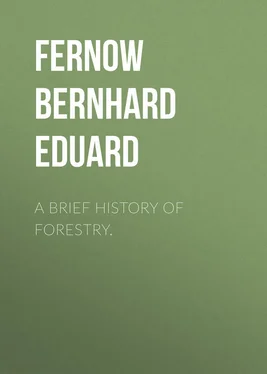Bernhard Fernow - A Brief History of Forestry.
Здесь есть возможность читать онлайн «Bernhard Fernow - A Brief History of Forestry.» — ознакомительный отрывок электронной книги совершенно бесплатно, а после прочтения отрывка купить полную версию. В некоторых случаях можно слушать аудио, скачать через торрент в формате fb2 и присутствует краткое содержание. Жанр: foreign_antique, foreign_prose, на английском языке. Описание произведения, (предисловие) а так же отзывы посетителей доступны на портале библиотеки ЛибКат.
- Название:A Brief History of Forestry.
- Автор:
- Жанр:
- Год:неизвестен
- ISBN:нет данных
- Рейтинг книги:5 / 5. Голосов: 1
-
Избранное:Добавить в избранное
- Отзывы:
-
Ваша оценка:
- 100
- 1
- 2
- 3
- 4
- 5
A Brief History of Forestry.: краткое содержание, описание и аннотация
Предлагаем к чтению аннотацию, описание, краткое содержание или предисловие (зависит от того, что написал сам автор книги «A Brief History of Forestry.»). Если вы не нашли необходимую информацию о книге — напишите в комментариях, мы постараемся отыскать её.
A Brief History of Forestry. — читать онлайн ознакомительный отрывок
Ниже представлен текст книги, разбитый по страницам. Система сохранения места последней прочитанной страницы, позволяет с удобством читать онлайн бесплатно книгу «A Brief History of Forestry.», без необходимости каждый раз заново искать на чём Вы остановились. Поставьте закладку, и сможете в любой момент перейти на страницу, на которой закончили чтение.
Интервал:
Закладка:
5. Methods of Forest Organization
As stated before, to Hartig and Cotta belongs the credit of having applied systematically on a large scale methods of forest organization for sustained yield; Hartig having been active in Prussia since 1811, and Cotta beginning to organize the Saxon forests in the same year. The method employed by Hartig, the so-called volume allotment, had been already formulated and its foundation laid by Kregting and others (although Hartig seems to have claimed the invention). But it was reserved to Hartig to build up this method in its detail, and to formulate clearly and precisely its application, as well as to improve the practice of forest survey, calculation of increment, and the making of yield tables. His method involved a survey, a subdivision, a construction of yield tables and the formulation of working plans, in which the principle according to which the forest was to be managed during the whole rotation was laid down for each district. The rotation was determined, divided into periods, finally of twenty years, and the periodic volume yield represented by all stands was distributed through all the periods of the rotation in such a manner as to make the periodic felling budgets approximately equal; or, since the tendency to increased wood consumption was recognized, an increase of the felling budget toward the end of the rotation was considered desirable.
Cotta based his system of forest organization upon a method described by a Bavarian, Schilcher (1796); it relied primarily upon area rather than volume division. This method was later on (1817), called by him Flaechenfachwerk (area allotment). It divides the rotation into periods and allots areas for each periodic felling budget. But before this time, in 1804, Cotta had himself formulated a method of his own, which combined the area and volume method, the volume being the main basis and the area being merely used as a check. While Hartig dogmatically and persistently carried out his difficult scheme, Cotta was open-minded enough to improve his method of regulation, and by 1820, in his Anweisung zur Forst-Einrichtung und – Abschaetzung , he comes to his final position of basing the sustained yield entirely on the area allotment, using the estimate of volume simply to secure an approximately uniform felling budget. He laid particular stress on orderly procedure in the subdivision and progress of the fellings. He did not prepare an elaborate working plan binding for the entire rotation, but merely prescribed the principles of the general management, and, after 1816, he confined the formulating of felling and planting plans only to the next decade.
A similar method, making a closer combination of volume and area allotment, now known as the combined allotment, in which the area forms the main basis for distributing the felling budgets, was prescribed by Klipstein in 1833. This, also, confines the working plan to the first period of the rotation and for this period alone makes a rather careful statement of the expected volume budget; a new budget is then to be determined at the beginning of the next period. This idea of confining the budget determination to a comparatively short period is now generally accepted, the future receiving only summary consideration.
These methods of organization were the ones generally applied in practice, and are still with some modifications in practical use. About 1820, however, new theories were advanced which led to the formulation of methods based upon the idea of the normal forest . The conception of a normal forest, with a normal stock, distributed in normal age classes, so as to insure a sustained yield management, was evolved, in 1788, by an obscure anonymous official in the Tax-collector’s office of Austria, designed for assessing woods managed for sustained yield. This fertile idea, which is still the basis of forest organization in Austria, and explains better than any other method the principles involved in forest organization, did not find entrance into forestry literature in all its detail until 1811 when André compared this so-called Cameraltaxe with Hartig’s method of regulation. We find, however, that, simultaneously with the Austrian invention of this method, Paulsen (1787) proposed to determine the felling budget as a relation between normal stock and normal yield, and in his yield tables (the first of the kind, 1795), he gives the proportion of increment to normal stock in percentic relation, so that the felling budget may be either expressed as a fraction of the stock or as a per cent.; in beech forests, for instance, he determines the felling budget as 3.3 % on best sites, 2.5 % on medium, and 1.8 % on poor sites.
Probably stimulated by André’s description, Huber (1812) developed a method and formula which may be considered the foundation of the later development by Carl Heyer

Based upon the normal forest idea, a number of methods were elaborated which, because of their employing a mathematical formula for the determination of the felling budget, are known as formula methods ; they are, indeed modified rational volume divisions.
Hundeshagen has the merit of having first clearly explained the basis of these methods, and himself developed a formula, of the correctness of which he was so convinced as to designate his method as “the rational” one. Two other formulæ were brought into the world by Koenig (1838-1851), but the credit of the most complete elaboration both of the principles of the normal forest idea and of its practical application belongs to Carl Heyer. The principles of his method are briefly: First determine upon the period of regulation during which the abnormal forest is to be brought nearer to normal conditions; the length of this period to be determined with due regard to the financial requirements or ability of the owner and to the conditions of the forest. The actual stock on hand is then determined and the total increment, based on the average increment at felling age of each stand, which will take place during this period, is added. Deducting from this total what has been calculated as the proper normal stock requisite for a sustained yield management, the balance is available for felling budgets which may be utilized in annual or periodic instalments during the period of regulation. A working plan is provided which takes care of securing an orderly progress of fellings and proper location of age classes, to be revised every ten years.
Although this is undoubtedly the most rational method yet devised, it has remained largely unused, and is found in somewhat modified application only in Austria and Baden.
An entirely new principle in the theory of forest organization was introduced, when the aim of forest management was formulated to be the highest soil rent. According to this requirement the proper harvest time of any stand, or even of any tree, was to be determined by the so-called index per cent., that is, a calculation which determines whether a stand or a tree is still producing at a proper predetermined rate, or is declining. The advocates of this principle were especially Pressler (professor of mathematics at Tharandt, 1840 to 1843) and G. Heyer , son of Carl Heyer, who based his method on his father’s formula, merely introducing values for volumes. Judeich , director of the Tharandt school, also developed in the sixties a method, based upon financial theory, which is to attain the highest rate per cent. on the capital invested in forest production. On the basis of survey and subdivision of working blocks composing a felling series, and with a rotation determined by financial calculations with interest accounts, he makes a periodic area division for determining the felling budget in general, and in addition employs the index per cent., as explained, for determining in each allotted stand the more exact time for its harvest.
Читать дальшеИнтервал:
Закладка:
Похожие книги на «A Brief History of Forestry.»
Представляем Вашему вниманию похожие книги на «A Brief History of Forestry.» списком для выбора. Мы отобрали схожую по названию и смыслу литературу в надежде предоставить читателям больше вариантов отыскать новые, интересные, ещё непрочитанные произведения.
Обсуждение, отзывы о книге «A Brief History of Forestry.» и просто собственные мнения читателей. Оставьте ваши комментарии, напишите, что Вы думаете о произведении, его смысле или главных героях. Укажите что конкретно понравилось, а что нет, и почему Вы так считаете.












